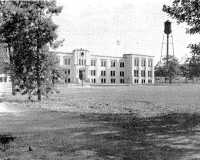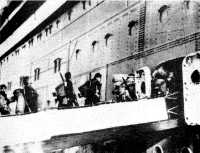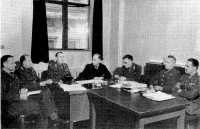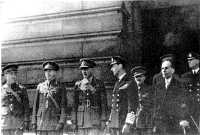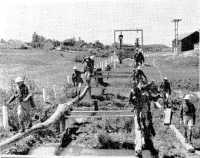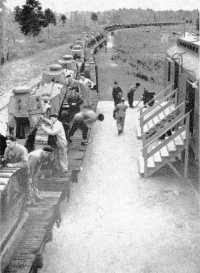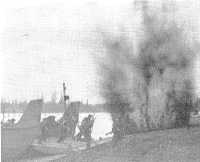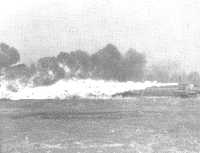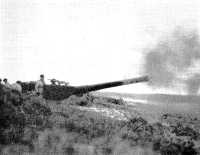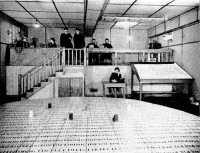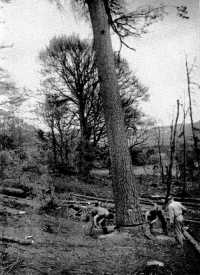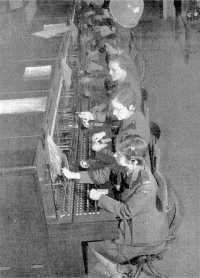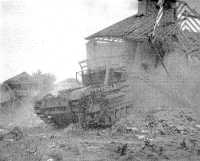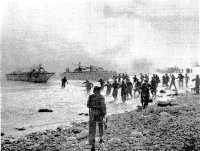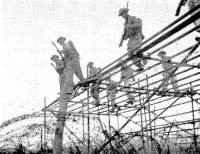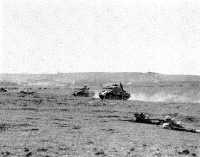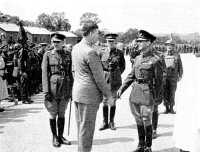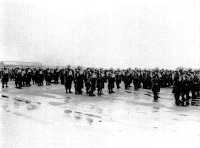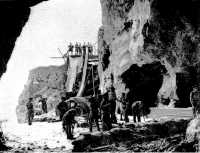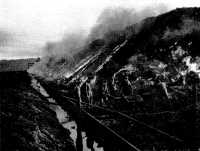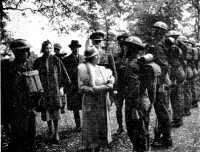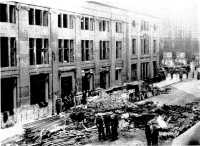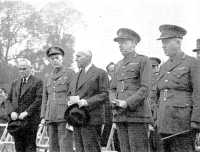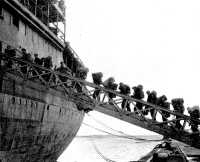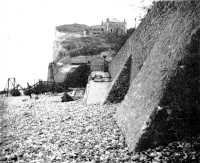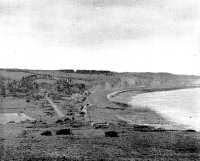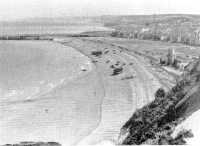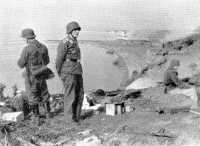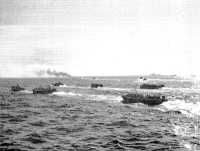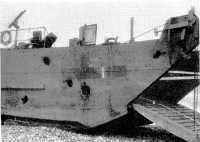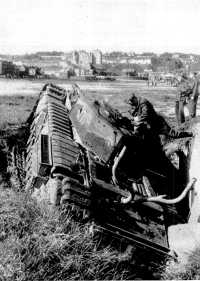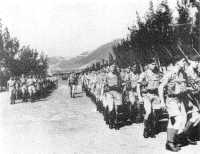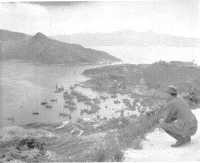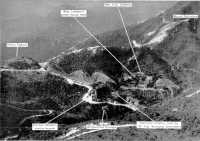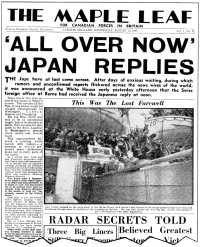Illustrations
Coast Defence in Canada – British Columbia A 9.2-inch gun (with a 6-pounder sub-calibre gun mounted upon it for practice purposes) at Albert Head Battery, Esquimalt, B.C. This battery was constructed under the coast-defence programme undertaken in 1977. Photograph Courtesy National Film Board
Vimy Barracks, Barriefield, Ontario This was one of the pre-war military stations constructed as unemployment relief projects. The photograph, taken in 1938, shows the Administration and Training Building which was taken over by the Canadian Signal Training Centre in August 1937. During the war R.C. Signals personnel and regimental signallers were trained here. Photo by Col. W. L. Laurie, Courtesy Director of Signals
Soldiers of the First Flight going aboard a transport at Halifax, December 1939
The Minister of National Defence in London, April 1940. This photograph taken at Canadian Military Headquarters shows, from left to right: Lt. Col. E. L. M. Burns, Maj. Gen. H. D. G. Crerar, Maj. Gen. W. H. P. Elkins (Master General of the Ordnance), Hon Norman McL. Rogers, Maj. Gen. A. G. L. McNaughton, Lt. Col. G. R. Turner and Lt. Col. A. E. Walford
Canadians at the Palace H.M. King George VI, with the High Commissioner for Canada and senior Canadian officers, watches the Royal 22e Régiment relieve the Welsh Guards at Buckingham Palace, 17 April 1940. From left to right are Brigadier the Hon. P. J. Montague, Maj. Gen. H. D. G. Crerar, Maj. Gen. A. G. L. McNaughton, H.M. the King, Lt. Col. A. E. Walford, and Hon. Vincent Massey
Basic Training in Canada Recruits on an obstacle course at Canadian Army (Basic) Training Centre No. 54, Montmagny, P.Q., June 1944
Renault Tanks Arriving From the United States, October 1940. Photograph courtesy Major General F. F. Worthington
One topic dealt with in Canadian-America staff conversations held in Washington in July 1940 was the possibility of Canada’s obtaining military supplies from the United States. After the Ogdensburg meeting between Mr. King and President Roosevelt in August the United States agreed to sell to Canada certain equipment including 250 obsolete and surplus light tanks. Canadian officers considered that in the absence of modern equipment these tanks, the U.S. version of the French 1917 model Renault two-man tank, would be useful for teaching driving and maintenance. The first shipment, 56 tanks, arrived on 4 October 1940. The photograph shows a shipment of 97 arriving at Camp Borden on 9 October
Combined Training Operations Training in Canada Assault training at the Combined Operations School, Courtenay, B.C., January 1944. Photograph Courtesy National Film Board
Flame-Throwing Demonstration, Valcartier A carrier-mounted flame thrower at A13 Canadian Infantry Training Centre, Valcartier Camp, P.Q., October 1944
Coast Defence in Canada – Nova Scotia A 6-inch gun engaged in practice firing at Sandwich Battery, Halifax, N.S.
A Gun Operations Room, Saint John Defences, New Brunswick This photograph taken in March 1943 shows officers and men of the Royal Canadian Artillery and members of the Canadian Women’s Army Corps assisting in controlling the anti-aircraft defences of Saint John
The Canadian Forestry Corps in Britain Men of No. 5 Forestry Company bringing down a Scotch Pine near Blair Atholl, Scotland, May 1941
The Canadian Women’s Army Corps Overseas CWAC operators at work on the telephone switchboard at Canadian Military Headquarters, London, September 1941
Training for the Dieppe Raid A Churchill tank of “A” Squadron 14th Army Tank Regiment (The Calgary Regiment) uses a bombed house to demonstrate its prowess during the training on the Isle of Wight, June 1942
Training in Assault Landings Canadian division troops embarking in personnel landing craft, October 1942, while undergoing training at the RCASC Battle School located at Cickmere Haven
Battle School in England Soldiers undergoing an obstacle course in the Battle Wing of the Canadian Training School, near Worthing, Sussex, June 1943
Training Before D Day. Men of the North Nova Scotia Highlanders in an exercise with Sherman tanks of the 27th Canadian Armoured Regiment (The Sherbrooke Fusiliers Regiment) at Wepham Downs, Sussex, 14 April 1944
The King With Canadian Troops, July 1941 This photograph was taken on the occasion when H.M. King George VI presented colours to The Carleton and York Regiment and The Edmonton Regiment at the Guards Depot, Caterham, Surrey, on Dominion Day. Left to right in the foreground, Lt. Gen. A. G. L. McNaughton, Hon. Ian A. Mackenzie (Minister of Pensions and National Health and former Minister of National Defence), Maj. Gen. G. R. Pearkes, VC, and the King.
Canadians Preparing to Leave for Norway, April 1940 princes Patricia’s Canadian Light Infantry on parade previous to leaving Aldershot for Scotland in the expectation of sailing to take part in the Norwegian campaign. Their embarkation was later cancelled.
Canadian Engineers at Gibraltar RCE tunnellers at work at Monkey’s Cave, Gibraltar, October 1941.
Engineers at Spitsbergen Men of the 3rd Field Company Royal Canadian Engineers engaged in setting fire to coal piles at Spitsbergen 1941.
The Queen Inspects a Guard of Honour. H.M. Queen Elizabeth, accompanied by Hon. J. L. Ralston, Maj. Gen. G. R. Pearkes, VC, and Lt. Gen. A. G. L. McNaughton, inspects a guard at Caterham, Surrey, during ceremonies held in connection with presentation of colours to the Saskatoon Light Infantry on 24 October 1942.
A Very Near Miss at CMHQ, London The results of the explosion of a bomb which fell in Pall Mall East, just outside the back door of the Sun Life Building (then housing the overseas headquarters of both the Canadian Army and the RCAF) on 11 October 1940.
Cabinet Ministers at Army Headquarters This photograph, taken at a church service at Headquarters First Canadian Army, 4 October 1942, shows in the foreground, from left to right, Hon. C. D. Howe (Minister of Munitions and Supply), Lt. Gen. A. G. L. McNaughton, Hon. J. L. Ralston (Minister of National Defence), Lt. Gen. Kenneth Stuart (Chief of the General Staff, Canada) and Maj. Gen. Hon. P. J. Montague.
Homeward Bound After Six Years. The Royal 22e Régiment, 1st Canadian Infantry Division, left Canada on 9 December 1939. This photograph, taken on 23 September 1945 at Southampton, shows men of the regiment boarding the troopship Nieuw Amsterdam which carried them back to Canada.
The Sea-Wall at Puys, Looking East This photograph taken in June 1945 shows the beach on which The Royal Regiment of Canada landed. The pillbox which was probably responsible for many of their casualties is visible immediately in front of the house on the east cliff. The lower pillboxes, just above the beach, are believed not to have existed in 1942.
Pourville From the East, 1946 “Merritt’s Bridge” is marked by its light colour. The houses on the sea-front were demolished by the Germans, some of them before the raid. The command possessed by the German positions on the east side of the Scie valley is evident.
The Main Beaches of Dieppe A German photograph taken at low water, probably on the morning of 20 August 1942, the day after the raid. Three tank landing craft, as well as smaller craft and tanks, appear clearly. The building at the right is the Casino. Beyond it appear the two tall chimneys of the Tobacco Factory.
Dieppe From the Western Headland This German photograph probably taken on the afternoon of the raid shows a tank landing craft (LCT 5) still burning in front of the Casino, and fires burning in the town.
Part of the Floating Reserve at Dieppe. Unarmoured landing craft carrying Les Fusiliers Mont-Royal circling off Dieppe previous to landing this unit on the main beaches.
Evidence of the Fierceness of German Fire at Dieppe. This German photograph of the bow of LCT 1, taken on the Dieppe beach at low water, shows marks of five shells which struck the craft within a very small area. This fire probably came from the west cliff.
A Disabled Tank on the Dieppe Promenade. A Churchill tank of the Calgary Regiment. In the background can be seen the Castle and the West Headland. Gun positions in the cliff are visible above the German soldier standing on the tank.
Canadian Troops Arriving at Hong Kong. This photograph shows The Winnipeg Grenadiers at Hong Kong on the day of their arrival, 16 November 1941. Courtesy Imperial War Museum, London
A Former Japanese Commander Surveys the Hong Kong Battlefield. Maj. Gen. Tanaka Ryosaburo (who was subsequently sentenced to a long term of imprisonment for war crimes) looks down on Devil’s Peak and Lye Mun Passage, the narrow strait across which his troops invaded Hong Kong Island on the night of 18 December 1941. Photograph courtesy Major G. B. Puddicombe, 1947
Wong Nei Chong Gap, Hong Kong Island. The scene of one of the fiercest encounters in the battle of Hong Kong. Here a company of The Winnipeg Grenadiers held out for several days and inflicted much delay and many casualties upon the Japanese, The island’s main north-south road runs from right to left across the picture. Photograph courtesy Major G. B. Puddicombe, 1947
Missing illustration: Landing at Kiska, August 1943. Aerial view of tank landing craft (LCT5s) and other craft engaged in landing men an supplies on a beach on the north-west shore of Kiska. The rugged and inhospitable Aleutian terrain is clearly illustrated here.
Missing illustration: The End of the War. On board the U.S. battleship Missouri in Tokyo Bay, Sunday 2 September 1945. General MacArthur, Supreme Commander for the Allied Powers, accepts the Japanese capitulation by signing the instrument of surrender. Colonel L. V. M. Cosgrave, who signed on behalf of Canada, is fourth from the bottom in the front rank of the large group of Allied officers at the right. The Japanese representatives are at the left.
The “Maple Leaf” Reports the End. Separate editions of the newspaper were published in Italy (January 1944–March 1945), North-West Europe (July 1944–May 1946) and the United Kingdom (May 1945–February 1946). Edited by personnel of the Canadian Army Public Relations Groups serving in each of the areas, it kept men and women of the Canadian forces informed of events at home and the progress of the war. Earlier the “Canadian Press News”, first published in May 1942, had served the same purpose in Britain. The cut on the page reproduced here shows General H. D. G. Crerar, lately GOC-in-C First Canadian Army, landing at Halifax on 5 August 1945 on his return to Canada.

